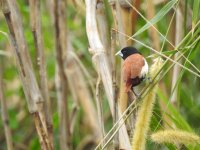lgonz1008
Well-known member

This is mostly for fellow American birders, but any input would be appreciated. Recently in Central Florida in an eBird hotspot called Belle Glade Marina & Torry Island birders have reported a number of Florida rarities like Vermilion Flycatcher, Tropical Kingbird and out of season Dicksissels. However, there has also been reports of a small flock of some birds that I could only consider escapees which are Tricolored Munia, beautiful finchlike bird from Asia that's known to have some feral populations around Central America, the Caribbean and Northern South America.
My question is the following, why is this species considered countable by ABA on the ground of vagrant birds from Cuba found in Florida are "wild birds"? How can they tell if it's vagrant or escaped and why is the ABA allowing such a species in the countable exotics lists, but not some birds that have been breeding within the ABA for decades?
Would love to get some input on this, since eBird has also blown up the past few weeks with dozens of birders going to see these birds, would any of you consider these birds worth the chase or would it be best to treat them like the introduced exotic waterfowl we see in city ponds and lakes around the world?
My question is the following, why is this species considered countable by ABA on the ground of vagrant birds from Cuba found in Florida are "wild birds"? How can they tell if it's vagrant or escaped and why is the ABA allowing such a species in the countable exotics lists, but not some birds that have been breeding within the ABA for decades?
Would love to get some input on this, since eBird has also blown up the past few weeks with dozens of birders going to see these birds, would any of you consider these birds worth the chase or would it be best to treat them like the introduced exotic waterfowl we see in city ponds and lakes around the world?






